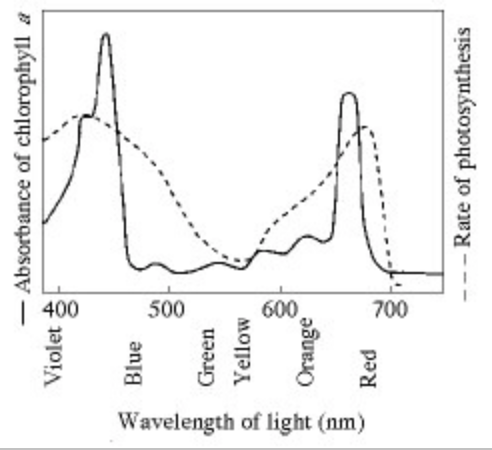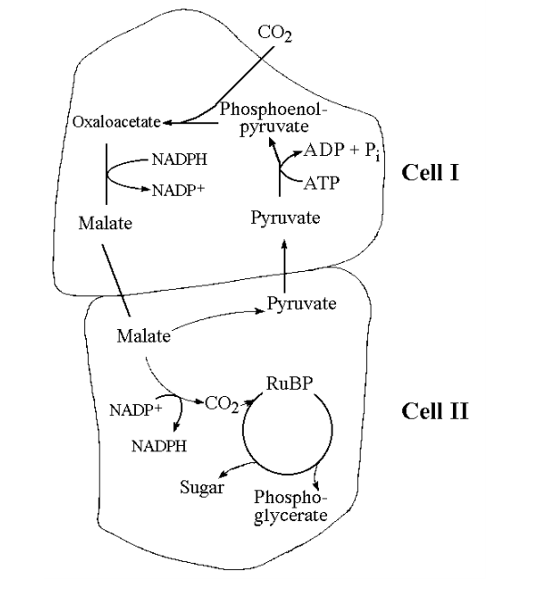Instructions for Side by Side Printing
- Print the notecards
- Fold each page in half along the solid vertical line
- Cut out the notecards by cutting along each horizontal dotted line
- Optional: Glue, tape or staple the ends of each notecard together
photosynthesis
front 1 Which type of organism obtains energy by metabolizing molecules produced by other organisms? A) autotrophs B)heterotrophs C)decomposers D)B and C E) A, B, C | back 1 d |
front 2 Which of the following are products of the light reactions of photosynthesis that are utilized in the Calvin cycle? a. CO2 and glucose b. h2o and o2 c. adp, pi, and nadp+ e. atp and nadph | back 2 e |
front 3 What are the products of the light reactions that are subsequently used by the Calvin Cycle? a.oxygen and carbon dioxide b.carbon dioxide and RuBP c. water and carbon d. electrons and phtons e. ATP and NADPH | back 3 e |
front 4 What wavelength of light in the figure is most effective in driving
photosynthesis? | back 4 a |
front 5  The figure shows the absorption spectrum for chlorophyll a and the action spectrum for photosynthesis. Why are they different? A) Green and yellow wavelengths inhibit the absorption of red and blue wavelengths. B) Oxygen given off during photosynthesis interferes with the absorption of light. C) Other pigments absorb light in addition to chlorophyll a. D) Aerobic bacteria take up oxygen, which changes the measurement of the rate of photosynthesis. | back 5 c |
front 6 In the thylakoid membranes, what is the main role of the antenna pigment molecules? a. split water and release oxygen to the reaction-center chlorophyll b. harvest photons and transfer light energy to the reaction-center chlorophyll c. synthesize ATP from ADP and Pi d.transfer electrons to ferredoxin and then NADPH e. concentrate photons within the stroma | back 6 b |
front 7 The reaction-center chlorophyll of this system is known as P700 because a. there are 700 chlorophyll molecules at this center b.this pigment is best at absorbing light with a wavelength of 700nm c.there are 700 photosytem I components to each chloroplast d. it absorbs 700 photons per microsecond e. the plastoquinone reflects light with a wavelength of 700 nm | back 7 b |
front 8 All of the events listed below occur in the light reactions of
photosynthesis except | back 8 c |
front 9 During photosynthesis, visible light has enough energy to a. force electrons closer to the nucleus b. excite electrons c. split a water molecule into hydrogen and oxygen d. B and C only e. A,B, and C | back 9 d |
front 10 Which of the following statements about the light reactions of photosynthesis are true? a. The splitting of water molecules provides a source of electrons. b. Chlorophyll (and other pigments) absorb light energy, which excites electrons. c. ATP is generated by photophosphorylation. d. Only A and C are true. e. A, B, and C are true. | back 10 e |
front 11 All of the following are directly associated with photosystem II
except | back 11 d |
front 12 What are the products of noncyclic photophosphorylation? a. heat and fluorescence b. ATP and P700 c. ATP and NADPH d. ADP and NADP e. P700 and P680 | back 12 c |
front 13 What does cyclic electron flow in the chloroplast produce? a. ATP b. NADPH c. glucose d. a and b e. a, b, and c | back 13 a |
front 14 As a research scientist, you measure the amount of ATP and NADPH
consumed by the Calvin cycle in 1 hour. You find 30,000 molecules of
ATP consumed, but only 20,000 molecules of NADPH. Where did the extra
ATP molecules come from? | back 14 c |
front 15 In mitochondria, chemiosmosis translocates protons from the matrix into the intermembrane space, whereas in chloroplasts, chemiosmosis translocates protons from a. the stroma to the photosystem II. b. the matrix to the stroma. c. the stroma to the thylakoid space d. the intermembrane space to the matrix. e. ATP synthase to NADP+ reductase | back 15 c |
front 16 Which of the following statements best describes the relationship between photosynthesis and respiration? a. Respiration is the reversal of the biochemical pathways of photosynthesis. b. Photosynthesis stores energy in complex organic molecules, while respiration releases it. c. Photosynthesis occurs only in plants and respiration occurs only in animals. d. ATP molecules are produced in photosynthesis and used up in respiration. e. Respiration is anabolic and photosynthesis is catabolic. | back 16 b |
front 17 Refer to the choices to answer the following questions. Each choice may be used once, more than once, or not at all. Indicate whether the following events occur during A. photosynthesis B. respiration C. both photosynthesis and respiration D. neither photosynthesis nor respiration synthesis of ATP by the chemiosmotic mechanism a. A b. B c. C d. D | back 17 c |
front 18 Refer to the choices to answer the following questions. Each choice may be used once, more than once, or not at all. Indicate whether the following events occur during A. photosynthesis B. respiration C. both photosynthesis and respiration D. neither photosynthesis nor respiration reduction of NADP+ a. A b. B c. C d. D | back 18 a |
front 19 Refer to the choices to answer the following questions. Each choice may be used once, more than once, or not at all. Indicate whether the following events occur during A. photosynthesis B. respiration C. both photosynthesis and respiration D. neither photosynthesis nor respiration the splitting of carbon dioxide to form oxygen gas and carbon compounds a. A b. B c. C d. D | back 19 d |
front 20 Where are the molecules of the electron transport chain found in
plant cells? | back 20 a |
front 21 Which of the following statements best represents the relationships
between the light reactions and the Calvin cycle? | back 21 a |
front 22 Which of the following is (are) required in the calvin cycle? A. CO2 B. ATP C. RuBP d. A and B only e. A, B, and C | back 22 e |
front 23 Which statement is false? A) Thylakoid membranes contain the photosynthetic pigments.
| back 23 c |
front 24 For the following questions, compare the light reactions with the Calvin cycle of photosynthesis in plants.Use the following key: A.light reactions alone B.the Calvin cycle alone C.both the light reactions and the Calvin cycle D.neither the light reactions nor the Calvin cycle E.occurs in the chloroplast but is not part of photosynthesis Produces molecular oxygen (O2)? a. A b. B c. C d. D | back 24 a |
front 25 For the following questions, compare the light reactions with the Calvin cycle of photosynthesis in plants.Use the following key: A.light reactions alone B.the Calvin cycle alone C.both the light reactions and the Calvin cycle D.neither the light reactions nor the Calvin cycle E.occurs in the chloroplast but is not part of photosynthesis Produces NADPH? a. A b. B c. C d. D | back 25 a |
front 26 For the following questions, compare the light reactions with the Calvin cycle of photosynthesis in plants.Use the following key: A.light reactions alone B.the Calvin cycle alone C.both the light reactions and the Calvin cycle D.neither the light reactions nor the Calvin cycle E.occurs in the chloroplast but is not part of photosynthesis Produces three-carbon sugars? a. A b. B c. C d. D | back 26 b |
front 27 For the following questions, compare the light reactions with the Calvin cycle of photosynthesis in plants.Use the following key: A.light reactions alone B.the Calvin cycle alone C.both the light reactions and the Calvin cycle D.neither the light reactions nor the Calvin cycle E.occurs in the chloroplast but is not part of photosynthesis Requires glucose? a. A b. B c. C d. D | back 27 d |
front 28 For the following questions, compare the light reactions with the Calvin cycle of photosynthesis in plants.Use the following key: A.light reactions alone B.the Calvin cycle alone C.both the light reactions and the Calvin cycle D.neither the light reactions nor the Calvin cycle E.occurs in the chloroplast but is not part of photosynthesis Inactive in the dark? a. A b. B c. C d. D | back 28 a |
front 29 Which of the following is (are) true of the enzyme ribulose
bisphosphate carboxylase? | back 29 d |
front 30 What are the substrates (normal reactants) for the enzyme RuBP carboxylase? A) CO2 and O2 | back 30 a |
front 31  Which of the following statements is true concerning the figure? a. It represents cell processes involved in C4 photosynthesis. b. It represents the type of cell structures found in CAM plants. c. It represents an adaptation that minimizes photorespiration. d. A and C are true. e. A, B, and C are true. | back 31 d |
front 32 Oxygen would inhibit the CO2 fixation reactions in a. cell I only. b. cell II only. c. neither cell I nor cell II. d. both cell I and cell II. e. cell I during the night and cell II during the day. | back 32 b |
front 33 In which cell would you expect photorespiration? a. Cell I b. Cell II c. Cell I at night d. Cell II at night e. neither Cell I nor Cell II | back 33 e |
front 34 Why are C4 plants able to photosynthesize with no apparent
photorespiration? | back 34 b |
front 35 CAM plants keep stomata closed in daytime, thus reducing loss of
water. They can do this because they | back 35 a |
front 36 Photorespiration lowers the efficiency of photosynthesis by
preventing the formation of | back 36 b |
front 37 Organisms that can exist with light as an energy source and an inorganic form of carbon and other raw materials a. are called photoautotrophs. b. do not exist in nature. c. are called heterotrophs. d. are best classified as decomposers. e. both C and D | back 37 a |
front 38 If photosynthesizing green algae are provided with CO2 synthesized
with heavy oxygen (18O), later analysis will | back 38 e |
front 39 A plant has a unique photosynthetic pigment. The leaves of this plant
appear to be reddish yellow. What wavelengths of visible light are not
being absorbed by this pigment? | back 39 a |
front 40 Of the following, what do both mitochondria and chloroplasts have in common? a. thylakoid membranes b. chemiosmosis c. ATP synthase d. B and C only e. A, B and C | back 40 d |